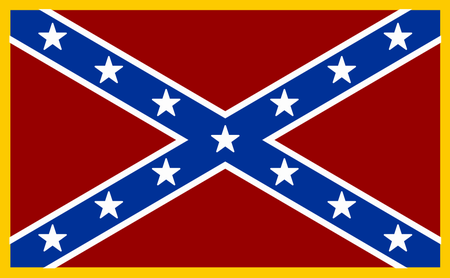
This image has format transparent PNG with resolution 450x278.
You can download this image in best resolution from this page and use it for design and web design.
Flag Confederate PNG with transparent background you can download for free, just click on download button.
Three successive designs served as the official national flag of the Confederate States of America (the "Confederate States" or the "Confederacy") during its existence from 1861 to 1865.
Since the end of the American Civil War, private and official use of the Confederacy's flags, and of flags with derivative designs, has continued under philosophical, political, cultural, and racial controversy in the United States. These include flags displayed in states; cities, towns and counties; schools, colleges and universities; private organizations and associations; and by individuals.
The state flag of Mississippi features the Confederate army's battle flag in the canton, or upper left corner, the only current U.S. state flag to do so. The state flag of Georgia is very similar to the first national flag of the Confederacy, the "Stars and Bars"; a prior design incorporating the Confederate battle flag was in use from 1956 until 2001.
The first official national flag of the Confederacy, often called the Stars and Bars, flew from March 4, 1861, to May 1, 1863. It was designed by German/Prussian artist Nicola Marschall in Marion, Alabama, and resembled the Flag of Austria, with which Marschall would have been familiar. The "Stars and Bars" flag was adopted March 4, 1861, in the first temporary national capital of Montgomery, Alabama, and raised over the dome of that first Confederate capitol. Marschall also designed the Confederate army uniform.
A monument in Louisburg, North Carolina, claims the "Stars and Bars" "was designed by a son of North Carolina / Orren Randolph Smith / and made under his direction by / Catherine Rebecca (Murphy) Winborne. / Forwarded to Montgomery, Ala. Feb 12, 1861, / Adopted by the Provisional Congress March 4, 1861".
One of the first acts of the Provisional Confederate Congress was to create the Committee on the Flag and Seal, chaired by William Porcher Miles, a congressman and Fire-Eater from South Carolina. The committee asked the public to submit thoughts and ideas on the topic and was, as historian John M. Coski puts it, "overwhelmed by requests not to abandon the 'old flag' of the United States." Miles had already designed a flag that later became known as the Confederate Battle Flag, and he favored his flag over the "Stars and Bars" proposal. But given the popular support for a flag similar to the U.S. flag ("the Stars and Stripes" – originally established and designed in June 1777 during the Revolutionary War), the "Stars and Bars" design was approved by the committee.
When the American Civil War broke out, the "Stars and Bars" caused confusion on the battlefield at the First Battle of Bull Run because of its similarity to the U.S. flag, especially when it was hanging limp, down on the flagstaff. The "Stars and Bars" was also criticized on ideological grounds for its resemblance to the U.S. flag. Many Confederates disliked the Stars and Bars, seeing it as symbolic of a centralized federal power the Confederate states were seceding from in order to preserve the institution of slavery. As early as April 1861, a month after the flag's adoption, some were already criticizing the flag, calling it a "servile imitation" and a "detested parody" of the U.S. flag. In January 1862, George William Bagby, writing for the Southern Literary Messenger, wrote that many Confederates disliked the flag. "Every body wants a new Confederate flag," Bagby wrote. "The present one is universally hated. It resembles the Yankee flag and that is enough to make it unutterably detestable." The editor of the Charleston Mercury expressed a similar view: "It seems to be generally agreed that the 'Stars and Bars' will never do for us. They resemble too closely the dishonored 'Flag of Yankee Doodle' … we imagine that the 'Battle Flag' will become the Southern Flag by popular acclaim." William T. Thompson, the editor of the Savannah-based Daily Morning News also objected to the flag, due to its aesthetic similarity to the U.S. flag, which for some Confederates had negative associations with emancipation and abolitionism. Thompson stated in April 1863 that he disliked the adopted flag "on account of its resemblance to that of the abolition despotism against which we are fighting."
Over the course of the flag's use by the Confederacy, additional stars were added to the flag's canton, eventually bringing the total number of stars on the flag to thirteen. This reflected the Confederacy's claims of having admitted Kentucky and Missouri into the Confederacy. Although they were represented in the Confederate Congress for the duration of its meetings, and had shadow governments made up of deposed former state politicians, neither state was ever fully controlled or administered by the Confederacy. The first showing of the 13-star flag was outside the Ben Johnson House in Bardstown, Kentucky; the 13-star design was also in use as the Confederate navy's battle ensign.
In this page you can download free PNG images: Flag Confederate PNG images free download